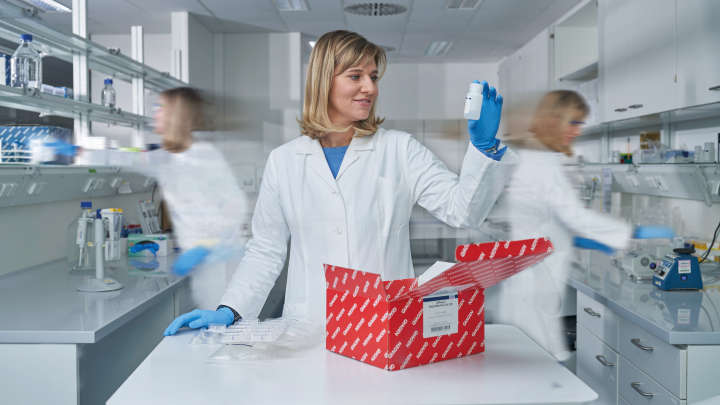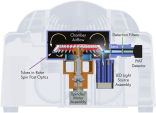✓ 24/7 automatic processing of online orders
✓ Knowledgeable and professional Product & Technical Support
✓ Fast and reliable (re)-ordering
Rotor-Gene Q MDx Platform (US)
Cat no. / ID. 9002035
✓ 24/7 automatic processing of online orders
✓ Knowledgeable and professional Product & Technical Support
✓ Fast and reliable (re)-ordering
Features
- Optimal thermal and optical performance due to rotary format
- Robust technology, requiring minimal maintenance
- Easy-to-use software with advanced security features
Product Details
Principle
Unique rotary design for outstanding performance
The Rotor-Gene Q MDx uses a sophisticated heating and cooling design to achieve optimal reaction conditions. The unique rotary format ensures optimal thermal and optical uniformity between samples, which is critical for precise and reliable analysis (see figure " Cross-section of the Rotor-Gene Q MDx"). Each tube spins in a chamber of moving air, keeping all samples at precisely the same temperature during rapid thermal cycling. Detection is similarly uniform. When each tube aligns with the detection optics, the sample is illuminated and the fluorescent signal is rapidly collected from a single, short optical pathway. This thermal and optical uniformity results in sensitive, precise, and fast real-time PCR analysis.
Robust optics for multiplex applications
With a choice of up to 6 excitation sources and 6 detection filters (the red and HRM channels are not intended for use with FDA cleared or approved nucleic acid tests), combined with a short, fixed optical path, the Rotor-Gene Q MDx can be used for multiplex reactions, ensuring minimum fluorescence variability between samples and eliminating the need for calibration or compensation.
Samples are excited from the bottom of the chamber by a light-emitting diode (see figure " Cross-section of the Rotor-Gene Q MDx"). Energy is transmitted through the thin walls at the base of the tube. Emitted fluorescence passes through emission filters on the side of the chamber and is then collected by a photomultiplier. The fixed optical path ensures consistent excitation for every sample, which means that there is no need to use a passive internal reference dye such as ROX.
| Channel | Excitation (nm) | Detection (nm) |
|---|---|---|
| Green | 470 ± 10 | 510 ± 5 |
| Yellow | 530 ± 5 | 557 ± 5 |
| Orange | 585 ± 5 | 610 ± 5 |
| Red* | 625 ± 5 | 660 ± 10 |
| Crimson | 680 ± 5 | 712 high pass |
| HRM* | 460 ± 20 | 510 ± 5 |
Minimum maintenance; maximum convenience
The Rotor-Gene Q MDx is engineered to reduce the need for maintenance, and to maximize ease of use. This saves time and costs, and keeps the instrument operational for continuous testing.
Convenient features of the Rotor-Gene Q MDx include:
- Lifetime guarantee on highly stable LEDs, no expensive and time consuming lamp replacement, and no gradual performance loss
- Cost-effective and easy temperature-accuracy verification
- Optical calibration not required at installation, or when the instrument is moved
- "Plug and play" connectivity between the computer and the instrument
- No sample block to clean
- No condensation or bubbles in the reaction due to rotation
- Small, light, and robust instrument — simply place it where you want it
See figures
Procedure
Nucleic acids are purified using the designated manual or automated purification kit that is validated for the downstream assay. After assay setup, the assays are then transferred to the Rotor-Gene Q MDx for PCR and data analysis.
Easy routine verification
Optical temperature verification (OTV) is a method that verifies the in-tube temperature in a Rotor-Gene Q MDx. While it is not required for the Rotor-Gene Q MDx, calibration of in-tube temperature can be a laboratory requirement. The OTV method provides a means for users to comply with this requirement, including if there are site-specific calibration intervals. OTV is performed using a Rotor-Disc OTV Kit. The full procedure takes less than 30 minutes and can be performed by any user.
Applications
The Rotor-Gene Q MDx instrument is intended for in vitro diagnostic use with FDA cleared or approved nucleic acid tests in clinical laboratories.
Software
Software enables quantification and enhances data security
The user-friendly software provides simplicity for beginners as well as an open experimental platform for advanced users. Assay packages contain the required files to run and analyze individual types of assays.
Data security, from starting the run to exporting the results, is assured by audit trails, digital signatures, and individual user management. Each Rotor-Gene Q MDx instrument is supplied with an unlimited software user license for your institute, enabling you to access and analyze your test results on as many computers as you want — in the laboratory, or in the office.
Supporting data and figures
Cross-section of the Rotor-Gene Q MDx.

Specifications
| Features | Specifications |
|---|---|
| heatdissipationthermalload | Average, 0.183 kW (632 BTU/hour); Peak, 0.458 kW (1578 BTU/hour) |
| operatingtemperature | 18-30°C (64-86°F) |
| humidity | 10-75% (noncondensing) |
| power | 100-240 V AC, 50-60 Hz, <520 VA (peak); Power consumption <60 VA (standby); Mains supply voltage fluctuations are not to exceed 10% of the nominal supply voltages; F5a 250 V fuse |
| placeofoperation | For indoor use only |
| pollutionlevel | 2 |
| opticalsystem | 6 channels; Excitation sources: High energy light-emitting diodes; Detector: Photomultiplier; Acquisition time: 4 seconds |
| overvoltagecategory | II |
| samplesperrunthroughput | Strip Tubes 0.1 ml (4 tubes) - 72 samples/run; Tubes 0.2 ml (not intended for use with FDA cleared or approved nucleic acid tests) - 36 samples/run; Rotor-Disc 72 (not intended for use with FDA cleared or approved nucleic acid tests) - 72 samples/run; Rotor-Disc 100 (not intended for use with FDA cleared or approved nucleic acid tests) - 100 samples/run |
| dimensions | Width, 37 cm (14.6 in.); height, 28.6 cm (11.3 in.); Depth (without cables), 42 cm (16.5 in.); Depth (door open), 53.8 cm (21.2 in.) |
| software | Rotor-Gene Q software 2.1.0 or higher, supplied on the installation CD provided |
| storageconditions | 15°C to 30°C (59°F to 86°F) in manufacturer's package; Max. 75% relative humidity (noncondensing) |
| technology | Real-time PCR cycler |
| thermalperformance | Temperature range, 35°C to 99°C (95°F to 210.2°F); Temperature accuracy, ±0.5°C; Temperature resolution, ±0.02°C (smallest programmable increment); Temperature uniformity, ±0.02°C (standard deviation) |
| transportationconditions | -25°C to 60°C (-13°F to 140°F) in manufacturer's package; Max. 75% relative humidity (noncondensing) |
| warranty | 1 year on instrument; lifetime guarantee on excitation LEDs |
| weight | 12.5 kg (27.6 lb.), standard configuration |
| altitude | Up to 2000 m (6500 ft) |




